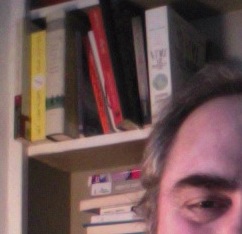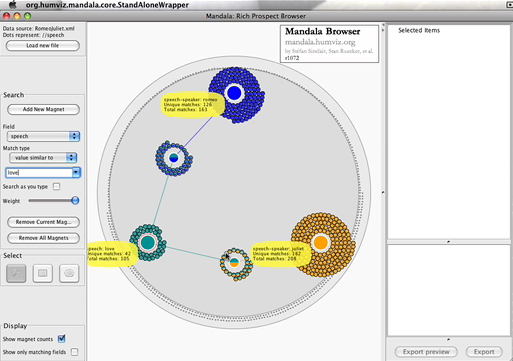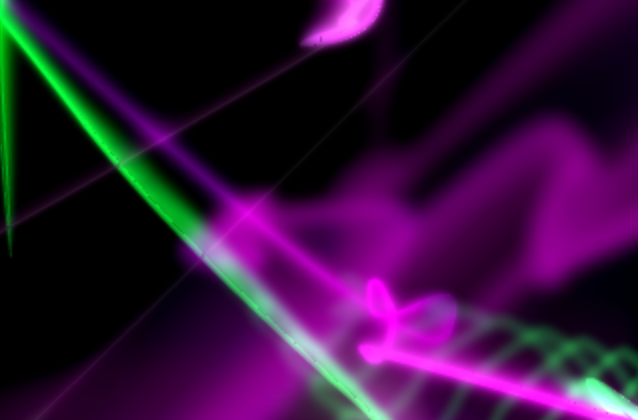 Well today is the day of the Day in the Life of the Digital Humanities project. We have about 100 people from around the world blogging what they do for a day as a form of autoethnography of a community. You can follow on the RSS feeds. My Day of DH blog (as opposed to this one) is at http://ra.tapor.ualberta.ca/~dayofdh/GeoffreyRockwell/
Well today is the day of the Day in the Life of the Digital Humanities project. We have about 100 people from around the world blogging what they do for a day as a form of autoethnography of a community. You can follow on the RSS feeds. My Day of DH blog (as opposed to this one) is at http://ra.tapor.ualberta.ca/~dayofdh/GeoffreyRockwell/
Neave Imagination …big wobbly elephants
Neave Imagination (…big wobbly elephants) is a lovely Flash toy that works great on a large screen.
Play with the big wobbly lines and you’ll soon have an active imagination.
Try his other toys – many are beautiful and they work on a 30″ screen.
Beatrice Warde: The Crystal Goblet
Reading the book on Canadian book design, The Surface of Meaning I came across a reference to Beatrice Warde’s The Crystal Goblet. This was given as a lecture in London in 1930 with the title “Printing Should be Invisible” and was printed in the 1950s. It is a clear and apparently influential statement of the modernist view of how a book design should be transparent letting the ideas shine through. It starts with a metaphor of the book as a goblet.
Imagine that you have before you a flagon of wine. You may choose your own favourite vintage for this imaginary demonstration, so that it be a deep shimmering crimson in colour. You have two goblets before you. One is of solid gold, wrought in the most exquisite patterns. The other is of crystal-clear glass, thin as a bubble, and as transparent. …
Bear with me in this long-winded and fragrant metaphor; for you will find that almost all the virtues of the perfect wine-glass have a parallel in typography. …
Now the man who first chose glass instead of clay or metal to hold his wine was a ‘modernist’ in the sense in which I am going to use that term. That is, the first thing he asked of his particular object was not ‘How should it look?’ but ‘What must it do?’ and to that extent all good typography is modernist. …
It is sheer magic that I should be able to hold a one-sided conversation by means of black marks on paper with an unknown person half-way across the world. Talking, broadcasting, writing, and printing are all quite literally forms of thought transference, and it is the ability and eagerness to transfer and receive the contents of the mind that is almost alone responsible for human civilization. …
the most important thing about printing is that it conveys thought, ideas, images, from one mind to other minds. This statement is what you might call the front door of the science of typography. …
Type well used is invisible as type, just as the perfect talking voice is the unnoticed vehicle for the transmission of words, ideas. ..
it is mischievous to call any printed piece a work of art, especially fine art: because that would imply that its first purpose was to exist as an expression of beauty for its own sake and for the delectation of the senses. Calligraphy can almost be considered a fine art nowadays, because its primary economic and educational purpose has been taken away; but printing in English will not qualify as an art until the present English language no longer conveys ideas to future generations, and until printing itself hands its usefulness to some yet unimagined successor. …
The book typographer has the job of erecting a window between the reader inside the room and that landscape which is the author’s words. He may put up a stained-glass window of marvellous beauty, but a failure as a window; that is, he may use some rich superb type like text gothic that is something to be looked at, not through. Or he may work in what I call transparent or invisible typography. …
Printing demands a humility of mind, for the lack of which many of the fine arts are even now floundering in self-conscious and maudlin experiments. There is nothing simple or dull in achieving the transparent page. Vulgar ostentation is twice as easy as discipline.
Perhaps the time comes when printing reluctantly hands off its usefulness to a digital successor like the Kindle which would explain the (re)discovery of pressing form into paper and other arts of the book. I am not making a prediction and especially not recommending this, just reflecting on how the book need not be so transparent as it was supposed to be. When the burden of usefulness is eased off the shoulders of books they can become post-modern chalices, opaque and shiny.
For another take see Book Design in Canada at Cardigan Industries.
Now for the wine within.
Ruecker’s One Minute Movies

My colleague Stan Ruecker has been create short online movies of humanities computing software tools he is involved in like the Mandala Browser and the Digital Profiles rich prospect browser. These are in the tradition of videos like A Vision of Students Today from the Digital Ethnography folk. There is also the TEI Encoding of Dylan’s Subterranean Homesick Blues. Neat idea – we should get more comfortable with YouTube as a way of conveying ideas.
HASTAC: Digital Textuality and Tools
Over the last few days I’ve been reading and contributing to one of the HASTAC discussion forms on Digital Textuality and Tools. This is led by Angela Kinney and Michael Widner.
Among other things there was a link to an interesting project, Inventoriana for collaborative annotation of manuscript images.
globeandmail.com: Universities promised stimulus flexibility
From yesterday’s Globe and Maill story Universities promised stimulus flexibility
“My research and development includes humanities,” Mr. Clement told reporters.
Congratulations to those who argued for a loosening of what stimulus funding could be spent on.
Top Gun – CBC News: the fifth estate
CBC: The Fifth Estate has a story, Top Gun: When a video game obsession turns to addiction and tragedy about the death of Brandon Crisp. They overstate the case against video games. Brandon died not from gaming but from a fall from a tree. Yes, he ran away from home angry that his parents wanted him to stop playing, but running away from home is not new to gaming. Nor is climbing trees. The story then gives us a tour through teenage addiction and peer pressure. The worst part is the porn of showing players concentrating on their playing. Why not show readers reading or people watching the TV? Is 7 hours a day of television a balanced life?
A more balanced view would argue that the problem was not the game but the social commitments that Brandon made to other online players. He got into conflict with his parents because of who he was hanging out with, what they were doing, when they were doing it and his commitments to his gaming buddies. In short he was hanging around with the wrong crowd and his parents tried to separate him from the social scene of the game.
Paying attention – Wolfram: Alpha
Wolfram|Alpha comes in May. Will it really compute knowledge? Epistemology in a command line. See Nova Spivak.
Gary Hall: Digitize this book
A couple of weeks ago I posted a blog entry about Gary Hall’s book Digitize This Book! I noted that I couldn’t find a digitized copy of the book and asked if others knew of one. To my surprise Gary wrote me back and pointed to the items listed below. Now that is the Internet at work! He is trying to get the publisher to allow a digital copy to be posted online, but in the meantime pointed out online versions of what became chapters in the book:
(2003) ‘Digitise This’, Mediactive, Vol. 1, No. 1 (pp. 76-90); republished in (2004), The Review of Education, Pedagogy and Cultural Studies, Vol. 26, No. 1, January-March (pp. 23-46) at http://scm-rime.tees.ac.uk/VLE/DATA/CSEARCH/MODULES/CS/2006/03/0147/_.doc (MS Word Document)
(2007) ‘IT, Again: or, How to Build an Ethical Virtual Institution’, in Experimenting: Essays With Samuel Weber, edited by Gary Hall and Simon Morgan Wortham (Fordham University Press: New York) (pp.116-140) at http://scm-rime.tees.ac.uk/VLE/DATA/CSEARCH/MODULES/CS/2008/01/0740/_.doc (MS Word Document)
Gary Hall says that “Since the book came out I’ve also published a new piece on open access publishing and the humanities” at http://www.culturemachine.net/index.php/cm/issue/current. A video of him presenting it as a talk is available at Pirate Philosophy – Steal This! .
I take back any irony in my previous post. (Can one take back irony? Perhaps I can only apologize for being ironic to early.)
What Is Infrastructure?
I’ve written another essay. It seems to be what I do in Sundays. This time I’m trying to work out What Is Infrastructure and how it is different from supplies? The question is a way into trying to understand the role of big projects like TAPoR or Bamboo, both of which I am involved in (at very different levels.) As I thought about it I came to a couple of conclusions:
- Defining things as infrastructure or cyberinfrastructure is a political move that tries to change how we frame services so we can propose different (and ongoing) ways of funding them. To be more blunt, defining a service as infrastructure moves it from something you ask for a limited grant for to something you ask for ongoing funding for (or something you set up a consortium to provide ongoing funding for.)
- I can imagine a lighter way of weaving infrastructure out of existing industry provided stuff that we should take seriously.
- Humanities research infrastructure should be public as in available to everyone and available internationally. Not only can the public participate in humanities research, but opening it up to the public is away of engaging them. Perhaps the relevance of the humanities lies not in their products, but in their participatory processes. Philosophy is not a science best done in a lab that will eventually produce a cure for ignorance. Philosophy is a love of wisdom we should share because we never owned it and we were never appointed its keepers.
Why not crowdsource the humanities? What would it take to make the (arts and) humanities the public disciplines? What sorts of infrastructure would engage the broader public?


